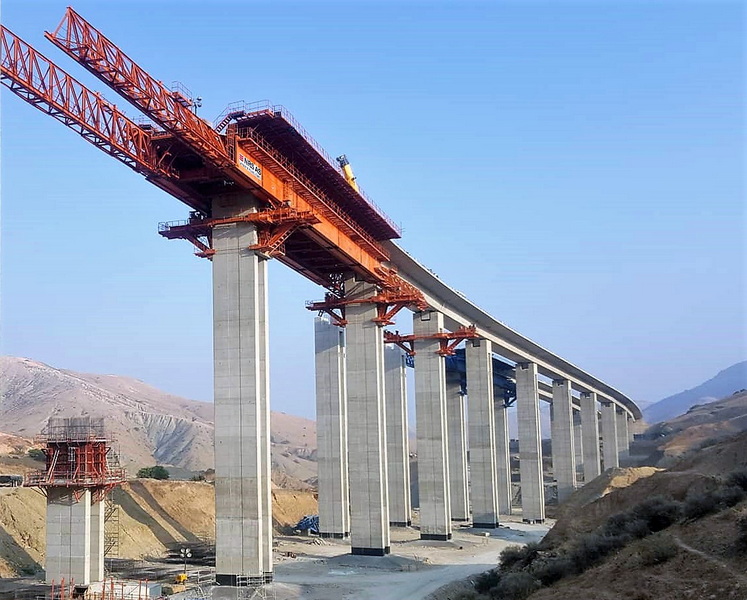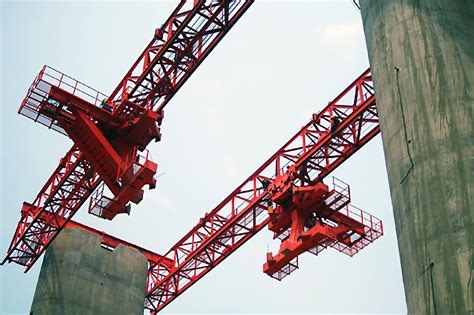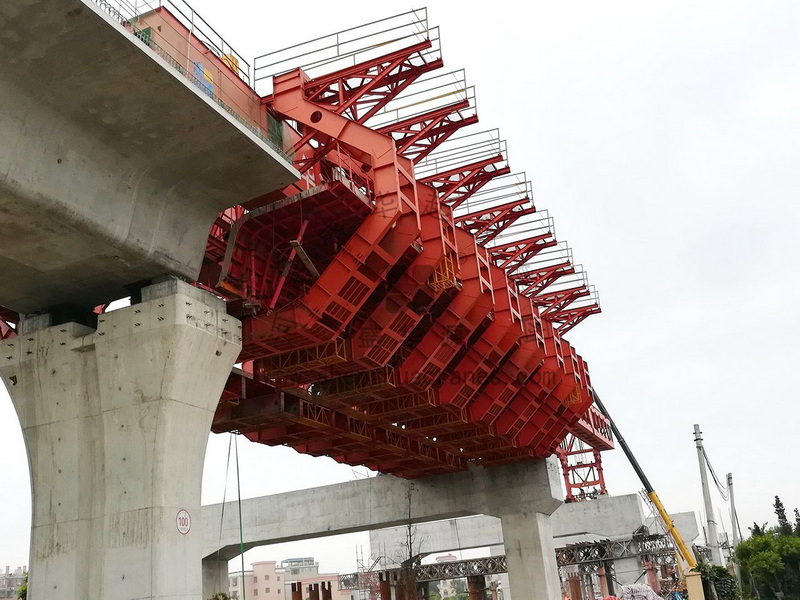Content Menu
● Understanding Movable Scaffolding Systems
● Types of Movable Scaffolding Systems
● Advantages of Using Movable Scaffolding Systems
● Challenges in Implementing Movable Scaffolding Systems
>> 1. Structural Stability
>> 2. Complexity of Design
>> 3. Logistical Challenges
>> 4. Cost Implications
>> 5. Safety Concerns
● Case Studies
>> Case Study 1: Rio Sousa Bridge
>> Case Study 2: NRS Movable Scaffolding System
>> Case Study 3: Thyssenkrupp Infrastructure
● Conclusion
● FAQ
>> 1.What is a movable scaffolding system?
>> 2.What are the advantages of using MSS in bridge projects?
>> 3.How does an overhead MSS differ from an underslung MSS?
>> 4.What safety measures should be implemented when using MSS?
>> 5.Can movable scaffolding systems be used for large-span bridges?
● Citations:
The construction of bridges is a complex and challenging endeavor, often requiring innovative engineering solutions to overcome various obstacles. Among these solutions, movable scaffolding systems (MSS) have emerged as a pivotal technology in modern bridge construction, particularly for cast-in-place concrete bridges. MSS offers numerous advantages, including enhanced efficiency, reduced construction time, and improved safety. However, the implementation of MSS in bridge projects is not without its challenges. These challenges range from structural stability and design complexities to logistical hurdles, cost implications, and safety concerns. This article delves into the multifaceted challenges associated with implementing movable scaffolding system in bridge construction, explores potential solutions, and provides real-world case studies to illustrate these points.

Understanding Movable Scaffolding Systems
A movable scaffolding system is a specialized, self-launching form used in bridge construction, specifically for prestressed concrete bridges with segments or spans that are cast in place[2]. Unlike traditional scaffolding, which remains stationary, an MSS moves continuously as each bridge segment is completed. This system supports the formwork while the concrete cures[2]. Once a segment is finished, the scaffold and forms are moved to the end of the new segment, and another segment is poured[2].
It is important not to confuse MSS with launching gantry machines, though they appear superficially similar. Both systems feature long girders spanning multiple bridge spans and move with the work to temporarily support it, but launching gantries lift and support precast bridge segments and bridge girders, whereas MSS is used for cast-in-place construction[2].
Types of Movable Scaffolding Systems
There are two primary types of MSS:
1. Overhead MSS: In this system, forms are suspended from support girders located above the bridge deck level[2].
2. Underslung MSS: Here, forms are supported by girders positioned below the bridge deck level[2].
Both types offer unique advantages depending on the specific requirements of the bridge project. For instance, underslung MSS can facilitate faster demolition of bridges[6].
Advantages of Using Movable Scaffolding Systems
Before discussing the challenges, it is essential to acknowledge the benefits that make MSS a preferred choice in many bridge construction projects:
- Reduced Joints: MSS minimizes the number of joints in the bridge structure, as the cast-in-place segments are typically longer than precast segments[2].
- Enhanced Structural Integrity: By reducing the number of joints, MSS enhances the overall structural integrity of the bridge.
- Efficient Operation: MSS allows for continuous construction, reducing downtime and accelerating project completion[4].
- Cost-Effectiveness: Despite the initial investment, MSS can lead to long-term cost savings through optimized design and reduced labor costs[4].
- Adaptability: MSS can be adapted to different cross-sections, allowing contractors to reuse the equipment for various projects[4].
Challenges in Implementing Movable Scaffolding Systems
Despite the numerous advantages, implementing movable scaffolding systems in bridge construction presents significant challenges that must be addressed to ensure the successful completion of the project.
1. Structural Stability
Ensuring structural stability is a paramount concern when using MSS. The inherent flexibility of scaffolding materials can lead to instability at joints and connections. This instability can be exacerbated by external factors such as wind loads, vibrations from nearby traffic, and the dynamic loads during concrete pouring.
Sub-Challenges:
- Wind Load: Bridges are often constructed in areas exposed to high winds, which can create significant lateral forces on the scaffolding structure.
- Dynamic Loads: The process of pouring concrete and moving the MSS itself introduces dynamic loads that can affect stability.
- Material Fatigue: Continuous use and exposure to environmental elements can lead to material fatigue, weakening the structural integrity of the scaffolding.
Solutions:
- Robust Bracing Systems: Implementing comprehensive bracing systems can enhance stability by distributing loads more evenly and reducing stress concentrations.
- Real-Time Monitoring: Employing sensors and monitoring systems to track structural deflections and stresses in real-time can provide early warnings of potential instability.
- Regular Inspections: Conducting regular inspections to identify and address any signs of wear, damage, or misalignment in the scaffolding structure.
2. Complexity of Design
The design of an MSS must consider a myriad of factors, including span length, load capacity, site conditions, and specific architectural requirements. Creating a system that is both efficient and adaptable to varying project needs can be an intricate task.
Sub-Challenges:
- Span Length Variation: Bridges often have varying span lengths, requiring the MSS to be adaptable to different configurations.
- Load Capacity Requirements: The MSS must be designed to support the weight of the formwork, wet concrete, construction equipment, and personnel, with an adequate safety margin.
- Site-Specific Conditions: Soil conditions, environmental factors, and accessibility constraints can all impact the design and operation of the MSS.
Solutions:
- Advanced Software Analysis: Utilizing sophisticated software for structural analysis can help engineers optimize the design of the MSS, ensuring it meets all performance requirements.
- Modular Design: Adopting a modular design approach allows for greater flexibility and adaptability, as individual components can be easily reconfigured or replaced to suit specific project needs.
- Collaboration Between Disciplines: Encouraging close collaboration between structural engineers, architects, and construction managers from the outset of the project can ensure that all design considerations are adequately addressed.
3. Logistical Challenges
Transporting and assembling MSS can be logistically challenging, particularly in remote or urban areas with limited access. The necessity for cranes and other heavy lifting equipment can escalate costs and complicate project scheduling.
Sub-Challenges:
- Limited Access: Many bridge construction sites are located in areas with limited road access or challenging terrain, making it difficult to transport large MSS components.
- Equipment Availability: Coordinating the availability of cranes and other lifting equipment can be problematic, especially in areas with high demand.
- On-Site Assembly: Assembling the MSS on-site requires skilled labor and specialized equipment, adding to the logistical complexity.
Solutions:
- Self-Launching MSS: Developing self-launching MSS that do not require external lifting equipment can significantly reduce logistical burdens and associated costs[4].
- Strategic Transportation Planning: Planning transportation routes meticulously and coordinating with local authorities can ensure the timely delivery of materials and equipment.
- Pre-Assembly: Pre-assembling as much of the MSS as possible off-site can minimize on-site assembly time and reduce the need for heavy lifting equipment.
4. Cost Implications
While MSS offers potential cost savings through enhanced efficiency, the initial setup costs can be substantial. The investment in advanced materials, specialized equipment, and skilled labor may deter some contractors from adopting these systems.
Sub-Challenges:
- High Initial Investment: The upfront costs associated with purchasing or renting an MSS can be prohibitively expensive for smaller construction firms.
- Maintenance Costs: Maintaining an MSS requires regular inspections, repairs, and component replacements, adding to the overall cost.
- Skilled Labor Costs: Operating and maintaining an MSS requires skilled labor, which commands higher wages.
Solutions:
- Thorough Cost-Benefit Analysis: Conducting a comprehensive cost-benefit analysis can help stakeholders understand the long-term savings potential of MSS compared to traditional methods.
- Financing Options: Exploring financing options such as leasing or partnering with equipment suppliers can alleviate the upfront financial burden.
- Value Engineering: Implementing value engineering principles can help optimize the design and construction processes, reducing costs without compromising performance.
5. Safety Concerns
Safety is of utmost importance in any construction project, particularly when working at heights with MSS. The dynamic nature of these systems necessitates that workers remain vigilant about potential hazards.
Sub-Challenges:
- Working at Heights: Constructing bridges involves working at considerable heights, increasing the risk of falls and other accidents.
- Equipment Malfunctions: Mechanical failures or malfunctions of the MSS can pose serious safety risks.
- Human Error: Errors in operation or maintenance can lead to accidents and injuries.
Solutions:
- Comprehensive Safety Training: Implementing rigorous safety training programs for all workers involved in the operation and maintenance of MSS is crucial.
- Regular Safety Audits: Conducting regular safety audits and inspections can help identify and address potential hazards before they lead to accidents.
- Adherence to Industry Standards: Following established industry safety standards and best practices can minimize risks and ensure a safe working environment.

Case Studies
To illustrate the challenges and solutions associated with implementing movable scaffolding systems in bridge construction, let's examine a few case studies:
Case Study 1: Rio Sousa Bridge
The Rio Sousa Bridge project in Portugal utilized an innovative overhead MSS to construct cast-in-situ concrete bridge decks[3]. The system featured a steel structure similar to a "bowstring," with an arched upper chord and a lower chord actively controlled by an organic prestressing system (OPS) during concrete pouring and deck prestressing[3].
Challenges:
- Complex Design: The bridge required a design that could accommodate spans up to 50 meters while maintaining structural stability[3].
- Load Capacity: The MSS needed to support the weight of the concrete, formwork, and equipment while minimizing mid-span deflection[3].
Solutions:
- OPS Technology: The implementation of OPS technology allowed for continuous monitoring of the scaffolding structure, enhancing safety levels and enabling mid-span deflection control[3].
- Transversal Structures: Transversal structures were designed to construct bridge decks with a maximum longitudinal slope of 5%, allowing for a polygonal construction with 5-meter-long segments, improving approximation to the directrix shape[3].
Case Study 2: NRS Movable Scaffolding System
The NRS MSS has been successfully deployed in numerous bridge projects worldwide, demonstrating its adaptability and efficiency[4]. Its lightweight design facilitates easier assembly and operation.
Challenges:
- High Construction Costs: Traditional MSS often require significant manpower and external lifting equipment, increasing construction costs[4].
- Accessibility: Accessing pier support brackets over water or on high piers can be difficult and costly[4].
Solutions:
- Self-Launching MSS (SL-MSS): NRS developed the SL-MSS, which can transfer forward and mount the pier support brackets without external lifting equipment, reducing costs and improving operational efficiency[4].
- Optimized Design: The NRS MSS features an optimized design that reduces the amount of steel required while maintaining high load capacity[8].
Case Study 3: Thyssenkrupp Infrastructure
Thyssenkrupp Infrastructure provided a custom solution for a semi-integral box girder bridge with over 30-meter tall piers and a standard span of up to 57 meters[9]. The project involved constructing two parallel superstructures with changing crossfalls and longitudinal inclines[9].
Challenges:
- Changing Crossfalls and Inclines: Adapting the formwork to the changing crossfalls and gradients of the bridge was a significant challenge[9].
- Limited Lifting Gear Capacity: The capacity of the lifting gear in the standard construction sections was limited[9].
Solutions:
- Three-Dimensionally Variable Bearing Construction: A movable scaffold running beneath the superstructure with a three-dimensionally variable bearing construction was chosen to adapt the position and shape of the formwork[9].
- Modular Pier Scaffold Structure: A modular pier scaffold structure was designed to minimize assembly weights when moving the scaffolds[9].
Conclusion
The implementation of movable scaffolding systems in bridge construction is a complex undertaking that presents numerous challenges. While MSS offers significant advantages in terms of efficiency, cost-effectiveness, and structural integrity, it is essential to address the associated challenges to ensure project success. By focusing on structural stability, design complexity, logistical hurdles, cost implications, and safety concerns, construction professionals can effectively leverage MSS technology to build bridges that are both durable and aesthetically pleasing. Innovation in design, materials, and construction techniques will continue to drive the evolution of MSS, making it an indispensable tool in modern bridge construction.

FAQ
1.What is a movable scaffolding system?
A movable scaffolding system (MSS) is a specialized, self-launching form used in bridge construction, particularly for prestressed concrete bridges with segments or spans that are cast in place[2]. It supports the formwork while the concrete cures and moves continuously as each segment is completed[2].
2.What are the advantages of using MSS in bridge projects?
MSS offers several advantages, including reduced joints, enhanced structural integrity, efficient operation, cost-effectiveness, and adaptability[2][4]. It minimizes the number of joints, improves overall structural integrity, reduces downtime, and can be adapted to different cross-sections for various projects[2][4].
3.How does an overhead MSS differ from an underslung MSS?
In an overhead MSS, forms are suspended from support girders above the bridge deck level, while in an underslung MSS, forms are supported by girders positioned below the bridge deck level[2]. Each type offers unique benefits depending on the project specifications[2].
4.What safety measures should be implemented when using MSS?
Safety measures include comprehensive training for workers, regular safety audits, robust bracing systems for stability, adherence to industry safety standards, and real-time monitoring of structural deflections and stresses[1][3].
5.Can movable scaffolding systems be used for large-span bridges?
Yes, movable scaffolding systems are particularly effective for large-span bridges due to their ability to support significant loads while maintaining structural integrity during construction[3][8]. Systems like the overhead movable scaffolding system have been used to construct bridges with spans ranging from 70m to 90m[3].
Citations:
[1] https://www.scafom-rux.com/en/scaffolding-blog/scaffolding-in-the-infrastructure-sector-types-of-scaffolding-and-challenges-in-bridge-construction
[2] https://en.wikipedia.org/wiki/Movable_scaffolding_system
[3] https://www.adfconsultores.com/media/3740/1568-movable-scaffolding-systems-strengthened-with-organic-prestressing.pdf
[4] https://www.nrsas.com/movable-scaffolding-system/
[5] https://www.researchgate.net/publication/263490753_Technical_Challenges_of_Large_Movable_Scaffolding_Systems
[6] https://products.huennebeck.com/systems/infrastructure-systems/movable-scaffolding-system
[7] https://www.adfconsultores.com/media/3744/1568-a-new-concept-of-overhead-movable-scaffolding-system-for-bridge-construction.pdf
[8] http://winsteel.in/products/movable-scaffolding-system/
[9] https://ucpcdn.thyssenkrupp.com/_legacy/UCPthyssenkruppBAMXInfrastructure/assets.files/downloads/downloads-tragger%C3%BCstbau/20190227_tkif_traggeruestbau_en_web.pdf






















